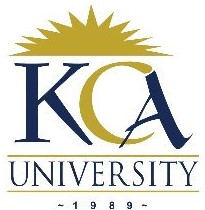 UNIVERSITY EXAMINATIONS: 2017/2018
UNIVERSITY EXAMINATIONS: 2017/2018
EXAMINATION FOR THE DEGREES OF BACHELOR OF SCIENCE IN
INFORMATION TECHNOLOGY
BIT2308 HUMAN COMPUTER INTERACTION
FULLTIME/ PART TIME/ DISTANCE LEARNING
ORDINARY EXAMINATIONS
DATE: APRIL, 2018 TIME: 2 HOURS
INSTRUCTIONS: Answer Question One & ANY OTHER TWO questions.
QUESTION ONE [30 MARKS]
a) Explain the following principles in HCI (6 Marks)
i) Affordance
ii) Usability
iii) Visibility
b) Discuss three main goals of HCI. (3 Marks)
c) Compare the constructivist and ecological theories of perception and give examples of how
each has influenced interface design. (4 Marks)
d) Describe, with the aid of a diagram, the Extended Human Information Processing
model. (4 Marks)
e) Distinguish between “knowledge in the World” and “knowledge in the head” (2 Marks)
f) Recognition and Recall are two common HCI concepts:
i) Differentiate between “recognition” and “recall” as used in HCI (2 Marks)
ii) Discuss areas in system design where ‘recognition’ is encouraged (2 Marks)
iii) Discuss areas in system design where ‘recall’ is encouraged (2 Marks)
g) Discuss any TWO metaphors used in the study of HCI and clearly show their importance in
system design. (4 Marks)
QUESTION TWO [20 MARKS]
a) What is the meaning of User-centered design? (2 Marks)
b) Discuss the audio and visual devices that are used for input and output. (3 Marks)
c) What is HOMERUN in reference to a usable website? (3 Marks)
d) Describe any TWO techniques used for evaluation, highlighting their key points and the
differences between them (12 Marks)
QUESTION THREE [20 MARKS]
a) Discuss any FOUR interaction styles that are applicable in computing and give their
advantages and disadvantages. (12 Marks)
b) Discuss KCA University website using Cognitive Task Analysis, GOMS (8 Marks)
QUESTION FOUR [20 MARKS]
a) An electricity power plant was redesigned so that the old system consisting of a single large
display screen which could be seen by all members of a team of three operators was
replaced by individual workstation screens for each operator. This worked well until there
was a problem which resulted in dangerous gases being released. The team of operators had
great difficulty in finding the source of the problem and deciding what to do. Because they
no longer had access to all the information, they had to spend time explicitly coordinating
their understanding of the situation by talking to each other. Under the old system, the
knowledge would be shared – one operator would know what was happening with another’s
area of the plant without explicit communication. Although the team’s individual
responsibilities would still have been clearly divided, the knowledge of the system would be
shared.
i) What is distributed cognition? (2 Marks)
ii) How could the new system of individual workstations be modified to make better use
of distributed cognition? (11 Marks)
b) Explain any FOUR facilities included in an interactive system that allows users to recover
from their mistakes (4 Marks)
c) How does evaluation fit into a user-centered design lifecycle? (3 Marks)
QUESTION FIVE [20 MARKS]
a) Why is web page design different to designing for printed media? (6 Marks)
b) What are design guidelines? (2 Marks)
c) Shneiderman produced eight golden rules as design guidelines for systems. Discuss any
FOUR of these rules (4 Marks)
d) What is meant by accessibility? (2 Marks)
e) Define Gestalt’s theory and demonstrate how this theory assists in system interface
development. (6 Marks)
